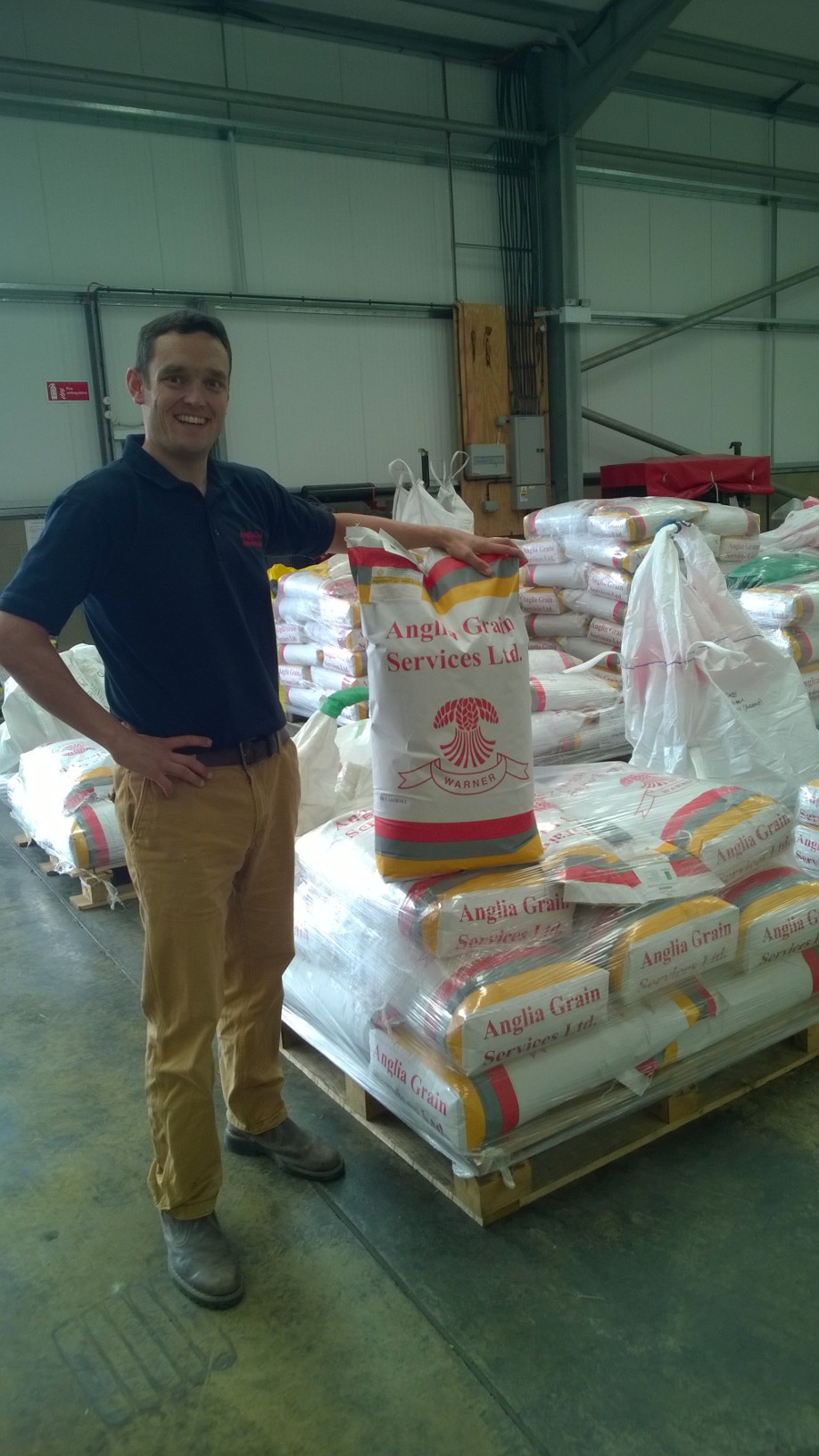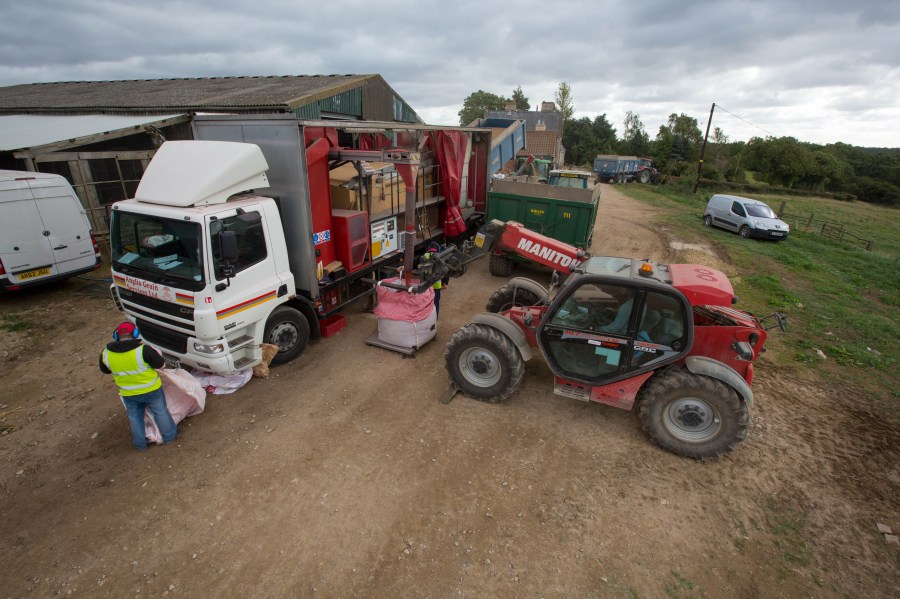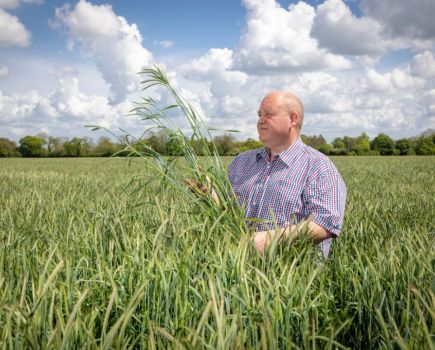As margins tighten across the board, input costs come under scrutiny. CPM finds out where farm-saving seed can be a helpful strategy.
I know the history of the field the seed is grown in.
By Olivia Cooper and Lucy de le Pasture
Each autumn a small army of mobile seed processors strikes out across the country taking on the challenge of cleaning and processing seed on farm. In a climate where margins are tight, home-saving seed gives growers the opportunity to retain well performing varieties at least cost, while being able to keep tighter control over disease risk and contamination, according to the members of the National Association of Agricultural Contractors (NAAC). Their estimates suggest £50-100 per tonne can be saved using farm-saved seed, as opposed to purchasing the equivalent certified seed.
“This cost reduction comes partly from the saving in haulage costs as the seed is already owned by and stored on the farm,” says Nigel Day of Anglia Grain Services. “Plus there’s an immediate royalty payment saving. Seed invoices are also lower, helping cash flow as the farmer already owns the grain.”
While plant breeders have a legal right to collect full rates of royalty on the C1 or C2 varieties they develop, there’s a significantly reduced rate on farm saved seed, he points out. Growers must declare this seed but it’s straightforward to administer through your local processor, he says, urging growers not to be put off by the seemingly complex system of royalties.
Tonnage basis
“Payment is made on a tonnage basis through a NAAC/ British Society of Plant Breeders (BSPB) registered processor or alternatively, it can be paid direct to BSPB,” he explains. “Anglia Grain Services simply add the payment to their invoice making it a simple and transparent process. We’re then audited by the BSPB, taking the onus away from our customers.”
Financial benefits can also be gained from disease or weed control when farm saving. This is an important factor for Lincs-based Agrii customer, Andrew Ward, who’s a keen farm-saver, buying in only 5% of his seed requirements each year.
“The seed we produce on farm is cleaner and less contaminated with weed seed that I can buy from a merchant. I know the history of the field the seed is grown in and I’m terrified of bringing in blackgrass due to our zero-tolerance policy on the farm,” he says. Many farmers take this approach, buying in a small percentage of their seed annually to maintain vigour and resistance through new varieties which they can multiply up, while farm saving favours varieties that suit their local conditions, he adds.
Advantage can also be gained by selecting seed based on proven yield potential on farm, says Nigel Day. Seed

Having made the decision to farm-save seed, think about which part of the field it’s going to come from, and treat it as a seed crop, advises Tim Eaton.
treatments can then be applied selectively, tailored to blocks of land and growing conditions, ensuring that money isn’t wasted on unnecessary products, while protecting crops where needed.
However, germination testing can be a wise investment, particularly if seed has been wet and then dried at high temperatures which may cause germination issues, he advises, adding that this can usually be done as part of the seed processor’s service.
If looking for control, however, farm saving is definitely the way to go, believes Rob White of Evans and Pearce. “The whole process happens in front of the farmer and he can control how hard the seed is screened and check that the treatment is being applied evenly and accurately.
“There’s no hiding place for the mobile seed processor. As a result, our customers usually get a higher thousand-grain weight due to heavier screening and therefore higher quality seed density, requiring lower seed rates at drilling,” he says.
But it’s not just cereals where there are potential savings to be made in seed costs. With low commodity prices and the neonicotinoid ban, the area of oilseed rape has declined, but farm-saving seed could be part of the answer to reducing input costs.
According to David Leaper of Agrii, OSR definitely still has a place in the rotation. As long as farmers achieve at least 3.5t/ha – or ideally 4t/ha – OSR really stacks up, with a predicted gross margin of £544/ha for a conventional variety yielding 3.5t/ha and priced at £265/t plus an oil bonus of £23/t, he says.
To spread the OSR harvest, he recommends growing an early variety like Advance alongside something like DK Exalte, DK Expower, Nikita or, further north, Anastasia. “They’re good vigorous autumn crops. Hybrids are also quite popular among growers looking for later crops.”
Hybrid varieties
However, farmers who are looking to cut costs by farm saving seed will have to avoid hybrid varieties, notes Tim Eaton of Anglia Grain. “Farm saving hybrid seed is illegal, and it’ll also revert to its parent stock, so you’ll end up with two distinct crops, neither of which is the hybrid variety.”
Rob White points out that conventional OSR varieties can also only be farm saved for one generation because of glucosinolate regulations, unlike cereal seed which can be saved year after year.
“Logistical issues may also be a limiting factor if farms don’t have the storage to segregate seed lots, or a wet, late harvest can sometimes mean seed can’t be separated for saving or gets dried too aggressively, reducing germination,” he warns.
That said, the benefits for many outweigh any disadvantages, particularly if high quality seed is initially grown and care is taken to farm save samples that aren’t contaminated with admixtures or weed seeds, believes Rob White.
Having made the decision to save your own seed, think about which part of the field it’s going to come from, and treat it as a seed crop, advises Tim Eaton. “You want a clean area with no volunteers, and you absolutely mustn’t spray it off with glyphosate as it can affect the germination. You can, however, use Reglone (diquat) as an alternative desiccant.”
The crop can be swathed or harvested direct, ideally at 8% dry matter to eliminate the need to dry it. You don’t want to be cooking the seed in the drier, he adds. Rob White agrees, saying, “If there’s a need to dry, the lowest possible

Rob White’s customers usually get a higher TGW due to heavier screening and therefore higher seed density.
temperature should be used – not exceeding 49°C.”
Although some farmers choose to clean their own seed to slash costs further, Tim Eaton recommends using a professional seed treatment firm, to produce the best seeds with greatest disease protection and maximum chances of successful growth.
“Big bold seed germinates much more aggressively than smaller seed as it has more energy reserves, so it’s very worthwhile cleaning it – we often will clean out 50% of the sample, which of course you can still sell commercially.”
The pre-cleaner sieves the seed, and then it’s gravity separated by weight, removing weed seeds in the process. “It’s then treated with a fungicide and micro-nutrients which protect against seed-borne diseases and aid root establishment, which is key to a successful OSR crop,” he adds.
Seed cleaning typically costs about £5/kg including the seed royalty. That compares to buying certified seed at about £12/kg. This saving can be used to sow at slightly higher seed rates for those who chose that route to overcome the threat of flea beetle and other grazing at establishment.
Another advantage is that the seed is on the farm and can be treated at relatively short notice, so there’s no anxious waiting for deliveries. Multiple visits from a processor are always an option so that varieties can processed as they are combined. It’s then important to keep all seed lots separate and to ensure they’re labelled with the variety name from harvest to drilling, adds Rob White.
With OSR there are very few seed-borne diseases to worry about, particularly if it’s been fungicide treated, says Tim Eaton. “Phoma and Alternaria are the two to look out for. Turnip Yellows Virus isn’t seed borne and in the absence of neonicotinoids isn’t something that can be controlled by a seed treatment.”
Thinking in Advance on farm-saved seed
Will Pope farms 182ha at Barford Farm, Sturminster Marshall, Dorset, and contract farms another 200ha nearby, as well as having a third 50ha farm near Weymouth. His rotation comprises wheat, oilseed rape, winter barley and peas, and he farm-saved some Advance rapeseed last year.
“I saw Tim Eaton at Cereals and he recommended Advance so we tried it, and it performed really well,” he says. “We hadn’t initially planned to save any seed – we’ve never done so before, but because of the neonicotinoid ban and as it looked so well, we decided it was worth saving some.”
Will Pope didn’t treat the seed crop much differently to the rest of the 24ha, just leaving a strip in the middle of the field undesiccated. “We left a whole 24m tramline and went back to cut it once we’d finished all the rest – it was fairly straightforward.”
He didn’t bother getting the seed screened or treated, but simply drilled 32ha with it this year which has grown away well. “We’ve saved almost £50/ha, which is well worthwhile.”
In the past Will Pope has grown Fashion, Charger and the hybrid DK Extrovert, and this year he’s also trying Picto and Campus. “I like to try new varieties,” he says. “I liked the Extrovert because it didn’t shatter in a heavy hailstorm, but it’s quite expensive. I think we’ll save either Picto or Campus this year and buy some more Advance to save next year.”
He found Advance to be a nice easy variety to grow. “It’s quite vigorous and has a high oil content – it beat all the other varieties on yield last year at 4.7t/ha, with oil at 46.8%,” he explains.
“It was also the first variety we cut – we don’t have enough storage so it’s good to get it out of the way as early as possible. That way we’re more likely to get hauliers before everyone else is combining.”
Last year Will Pope started harvesting on 14 July, and he reckons he could be going by 18 July this year if the weather improves. “The Advance is just starting to change colour, and it looks really good. I like that it’s so straightforward to farm-save: it grows and produces, which works for me.”
Have a Seed Processor Visiting?
- Prepare a list of seed to be cleaned and/or treated
- Have seed ready in a trailer with a discharge spout and a tractor to tip it
- If rain is forecast, have sheeting ready as seed needs to be kept dry
- Make sure bags are fit for purpose
- Provide a clean and level working site.




